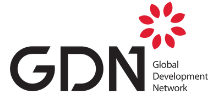Reflections on the Value of ‘Intermediaries’ for Fair and Practical Collaboration in International Development Research
This is a repost from an invited contribution published on the website of the UK Collaborative on Development Research.

Photo credit: Delmaine Donson/iStock
Author: Francesco Obino, Director | Research and Programs, Global Development Network
Given the diversity inherent in international development, it is no surprise that collaboration remains a crucial topic. But collaboration in this space must account for a surprising amount of diversity and difference.
Consider the following three categories: researchers; research ‘stakeholders’; and research funders. These three categories consist of many different types of people holding radically different perspectives on international development. Each one of these categories, furthermore, can be surprisingly diverse, to the point of rendering these labels borderline fictional. For example, researchers can be ‘early-career’ or ‘senior’, Northern or Southern (an oversimplified binary), and their work can aim at any combination of disciplines. Funders, in turn, might be banks (national, regional, global), government agencies, international organizations, private foundations, or businesses… Not to forget the occasional crowdfunded research project.
If the actors making up this space we call ‘international development research’ are both fundamentally different and fundamentally diverse, each bringing their own range of objectives, interests, claims, rules, knowledge, power and capacities, at a fundamental level collaboration must be the magic sauce that makes it possible to talk of a sector.
Operationally, this is rarely easy or rosy. Differences can lead to a lack of interest in engaging with one another, or even conflict. To help navigate the ongoing discussion on collaboration, replete with crisscrossing guidelines, principles and statements of purpose, I suggest we look at intermediaries: those organizations existing in the ambiguous space between international development researchers and funders.
One such intermediary is the Global Development Network, where I have worked for eight years. Others include INASP, Southern Voice, On Think Tanks, START, the Adaptation Research Alliance (ARA), the Latin American Council of Social Sciences (CLACSO), and the Rethinking Research Collaborative (RRC), and so many more, including some donors. My experience leads me to think that these organizations are instrumental to achieving collaboration, and I am convinced they will be increasingly important in achieving quality collaborations.
Below, I list five ways in which those working ‘in-between’ can help bridge the gap between researchers and funders.
Intermediaries are, by necessity, translators.
Intermediaries develop rules and processes that satisfy both the funder and the research institution implementing a project. Intermediaries often have more incentives than funders to learn about, and adapt to, the needs of researchers. They also have more means and independence than researchers to develop practical solutions that ensure specific standards important to the funder. Simply put, intermediaries flex the collaboration muscle for others. An intermediary could, for example, set up a dedicated research ethics review process for funding research projects in Myanmar, a country where the official route to ethics review is reported to be a form of open political control of research.
Intermediaries can be, by opportunity, innovators.
Collaboration is as much about finding practical ways to work together as it is about finding new ways to work. Being ‘in-between’ can provide a unique vantage point to do both. For example, intermediaries see opportunities where funders don’t. GDN has developed a toolkit to fund demand-driven development of research institutions that uses small grants instead of ‘core funding’. Sometimes intermediaries are well placed to imagine new ways of working. The US National Science Foundation is working with GDN and the InterAmerican Institute for Global Change Research to support Belmont Forum researchers to better align with UNESCO Open Science recommendations, by introducing advisors focused on the ‘curation’ of transdisciplinary collaboration in research projects.
Intermediaries excel, by profession, at technical support.
Experience is key to capacity. The centrifugal experience of being an intermediary in international development research involves working with multiple donors, across countries, languages, and sectors. This gives one a dramatically wide exposure to what can go right and wrong in international development research, why this happens, and the difference context can make. This cumulative knowledge, if managed with a grain of salt, can bolster the capacity of somebody working as an ‘intermediary’ to make collaborations work. It’s one essential ingredient of the secret sauce keeping the international development research space together.
Intermediaries are, by vocation, great at synthesis and interpreting change.
Intermediaries have a unique vantage point on the evolution of the sector. The diversity of exposure, experience and interactions can be much wider than those of funders or researchers respectively. This professional knowledge can give birth to ambitious efforts to generate evidence on the trajectory of the sector as a whole, as is the case of the global Doing Research initiative. This initiative mobilizes Southern researchers and donors to analyze the conditions in which they work, in countries such as El Salvador, Bolivia, Nigeria, Indonesia. This is significant because, as the Center for Capacity Research has been advocating, international development research needs its own internal evidence base to succeed.
Intermediaries can be very strong conveners.
If researchers are good at finding researchers, and funders are good at finding other funders, intermediaries can convene very diverse groups spanning both categories. GDN’s Global Development Conferences are a great example of this convening function. Collaborations among those who attend seem to flourish and thrive – and the fact that more than 60% of attendees are Southern social scientists, and the rest policy actors and research funders, works as a great draw for Northern researchers too.
To conclude, we should value more professional ‘in-betweeners’. They play a range of functions that enable collaboration. Funders (think of the role IDRC played in the Think Tank Intiative), and researchers (too many examples to choose from!), can also enable collaboration, but they can easily run into conflicts of interest if they try to wear both hats. Moving away from the dismissive rhetoric around intermediaries as a ‘transaction cost’, I call on donors in the sector to embrace the importance of these players for making collaboration – and hence the sector and its evolution – possible. Let’s start talking about how to cost this role and how to be better intermediaries – the quality of collaboration (from equity and fairness to decolonizing research) will likely depend on intermediaries.
Also published on the UKCDR Blog





